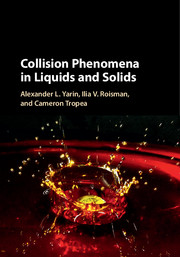Book contents
- Frontmatter
- Contents
- Preface
- 1 Introduction
- 2 Selected Basic Flows and Forces
- Part I Collision of Liquid Jets and Drops with a Dry Solid Wall
- Part II Drop Impacts onto Liquid Surfaces
- Part III Spray Formation and Impact onto Surfaces
- Part IV Collisions of Solid Bodies with Liquid
- Part V Solid–Solid Collisions
- 12 Particle and Long Bar Impact onto a Rigid Wall
- 13 Shaped-charge (Munroe) Jets and Projectile Penetration
- 14 Fragmentation
- Index
- References
14 - Fragmentation
from Part V - Solid–Solid Collisions
Published online by Cambridge University Press: 13 July 2017
- Frontmatter
- Contents
- Preface
- 1 Introduction
- 2 Selected Basic Flows and Forces
- Part I Collision of Liquid Jets and Drops with a Dry Solid Wall
- Part II Drop Impacts onto Liquid Surfaces
- Part III Spray Formation and Impact onto Surfaces
- Part IV Collisions of Solid Bodies with Liquid
- Part V Solid–Solid Collisions
- 12 Particle and Long Bar Impact onto a Rigid Wall
- 13 Shaped-charge (Munroe) Jets and Projectile Penetration
- 14 Fragmentation
- Index
- References
Summary
The present chapter begins with the study of ice particle collision with a solid wall (Section 14.1) and the consequences of such a collision, e.g. particle attrition and splitting (Section 14.2). The fracture of the target and projectile during normal penetration is described in Sections 14.3 to 14.5 using a model of chaotic disintegration modifying the theory of chaotic disintegration of liquids. The radius of the locally smallest fragment is calculated equating its kinetic energy of deformation with its surface energy of fracture. The probability of lacunae opening in the target and projectile materials increases near the target/projectile interface. The percolation threshold for this probability determines the boundary of the fractured zone. When this fractured zone reaches the rear surface of the target, the fragments can leave it. Mass distribution of the fragments was calculated with the help of percolation theory. Then, the shape of the debris cloud and the direction, velocity and range of its propagation are calculated to estimate vulnerability behind the perforated target (Section 14.6). The effect of plastic dissipation on debris sizes is estimated in Section 14.7.
Ice Particle Collision with a Dry Solid Wall
The reason for interest to better understand ice particle impact is mainly in the attempt to model and predict potential damage which such impact can cause on solid structures. It is important for ship building and the design of aircraft, arctic and space research. Moreover, ice crystal impact in hot environments, e.g. in aircraft engines or on heated measurement instruments can lead to ice accretion. Melting and subsequent shedding of the accumulated ice layer can result in even greater damage, e.g. impact onto aircraft compressor stages.
Experimental investigation of impact in laboratories using artificial, simulated ice particles is the main source of the knowledge about mechanisms of particle deformation and breakup (Hauk et al. 2015). The impact is observed using high-speed video systems. Many studies are focused on characterization of the kinematics of the post-impact fragments (Vargas et al. 2014, Emery et al. 2004, Vidaurre and Hallett 2009, Guégan et al. 2011). In particular, the restitution coefficient of the ice particles is measured (Hatzes et al. 1988, Higa et al. 1998). Images of a high-speed hail ice impact showing details of its deformation and fragmentation, captured using a high-speed video system, can be found in Tippmann et al. (2013).
Information
- Type
- Chapter
- Information
- Collision Phenomena in Liquids and Solids , pp. 566 - 603Publisher: Cambridge University PressPrint publication year: 2017
